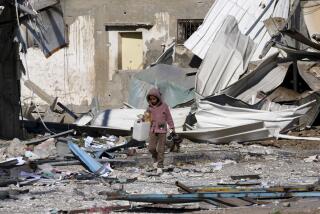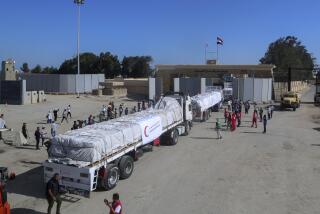Next Step : (Creative) Help Wanted : The U.N. is recruiting intrepid international experts to rebuild Somalia.
- Share via
MOGADISHU, Somalia — After 31 years as an air-traffic control expert with the Federal Aviation Administration, Ernie Wickersham was peacefully retired in Plainfield, Ind., giving a few flying lessons, running a charter occasionally and generally enjoying the peace and quiet of his golden years.
Then the United Nations called with a golden opportunity: the chance to rebuild an international airport in the most devastated land on the globe. So, here’s Ernie Wickersham these days in the demolished Somali capital, commuting from a makeshift hotel through dangerous streets swarming with international peacekeeping troops to his new office: a control tower blowtorched out of a discarded shipping container and stacked on top of four others just like it, accessible only by a wobbly wooden stepladder.
“But hey, this is great. I enjoy it. It’s a challenge,” the spry and gray-bearded Wickersham said the other day, summing up his new assignment as “a milestone.
“If it works, the sky’s the limit.”
And so are the opportunities.
Ernie Wickersham is among the first of a new breed of international reconstructionists now working on the tattered fringes of the “new world order” with an unprecedented mandate to help rebuild a nation that utterly self-destructed.
With $130 million in international donations already pledged to the U.N. effort to rebuild Somalia, the possibilities are almost endless.
In fact, the biggest problem facing the new U.N. mission in charge of the reconstruction effort is finding enough Ernie Wickershams--daring, creative and intrepid international experts. They are needed to help the Somalis lay the foundation stones of a nation where every institution--from law and government to transportation and banking--was demolished during a two-year civil war that starved hundreds of thousands to death and left virtually every building a gutted and roofless shell.
“The question is: How do you take a nation that is flat and help it to rebuild?” said retired U.S. Navy Adm. Jonathan Howe, who took over the U.N. mission in Somalia just before the last U.S. troops withdrew last week. “And we may be able to get the best people only for short periods of time.”
Howe also conceded that the $130 million in pledges for construction represent less than 10% of the total $1.5-billion package the United Nations has authorized for the post-U.S.-led international effort to save Somalia.
Still, he said his mission is planning to hire nearly 2,000 reconstruction experts like Wickersham--among them, he hopes, many Somalis. Already, the retired admiral has managed to attract a small but extraordinary array of short-term talent.
There is, for example, Martin Ganzglass, a Washington labor lawyer who three decades ago served in the Peace Corps in Somalia. Last month, he was paid to return to Somalia, tour its ravaged capital and countryside and draft a 43-page report that Howe’s agency now hopes will serve as a blueprint to re-create the Somali criminal justice system. The plan involves building upon auxiliary police forces that were formed by the U.S.-led intervention force during the last five months.
Already, several thousand members of the nation’s national police, a highly professional force that was largely aloof from former dictator Mohamed Siad Barre’s regime, have joined the force.
In contrast, it is the basic, technical infrastructure of Somalia that experts like Ernie Wickersham must re-create from nothing. And his $1-million, U.N.-financed project is emblematic both of the vast task at hand and of the creativity that the United States and United Nations hope will become a model.
At the core of Wickersham’s plan is the concept of “sustainability”--creating a structure at Mogadishu International Airport that will allow it to operate on its own steam long after he and the U.N. start-up funds are gone.
Here’s how he and the United Nations hope it will work:
Wickersham is using the $1 million to hire and train a core group of African air-traffic controllers, experts from Kenya, Tanzania, Uganda.
Now, he is recruiting former Somali airport controllers.
Simultaneously, Brown & Root--the Texas-based reconstruction giant whose job is to build the U.N.’s basic operational infrastructure for the peacekeeping operation in Somalia--is finishing a new building at the airport to serve as a flight-information center.
Then, Wickersham hopes, will come the real payoff.
Under international aviation regulations, any nation that provides such services must be compensated by the airlines that pass through its airspace. And, in Somalia’s case, that would mean revenue of up to $300,000 each month.
If only it was so simple.
“I call this Mission Improbable,” he said. “Really, what I hope to do is to make the transition from military to civilian, and hand over to the Somalis what are really vast commercial aspects.
“If we can provide air controllers, firefighters and the rest, well, then pilots will want to come here; tourists will want to come here. And then, well, the sky really is the limit.”
More to Read
Sign up for Essential California
The most important California stories and recommendations in your inbox every morning.
You may occasionally receive promotional content from the Los Angeles Times.










